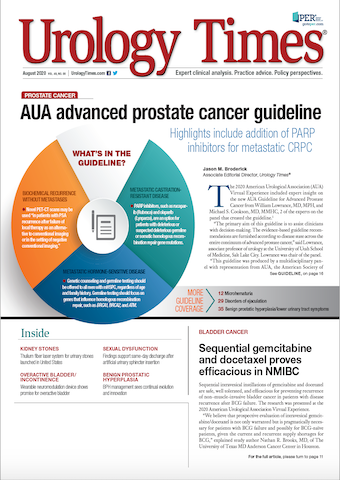Publication
Article
Urology Times Journal
New super‐pulse thulium fiber laser system for urinary stones launched in US
Author(s):
The Soltive Laser System, which uses thulium fiber laser technology, has been shown to generate finer particulate and dusted stones in half the time as a standard holmium yttrium aluminium garnet laser.
Bodo Knudsen, MD

The Soltive™ SuperPulsed Laser System (Soltive Laser System) has been launched in the United States as an option for urologists to use for stone lithotripsy and soft tissue applications.1
The Soltive Laser System, which uses thulium fiber laser technology, has US FDA 510(k) clearance. In a clinical trial, the Soltive system generated finer particulate and dusted stones in half the time as a standard holmium yttrium aluminium garnet (Ho:YAG) laser.2 Among other benefits, Soltive has also demonstrated an infinitesimal level of retropulsion.
“The SuperPulsed thulium fiber laser is a game changer. Besides being faster, this laser dusts stones into very fine particles that more easily wash out during the procedure, which is a significant benefit for patients,” Bodo Knudsen, MD, director of the Comprehensive Kidney Stone Program at Ohio State University, who was the first clinical user of the Soltive Laser System, stated in a press release.
In a pivotal trial, Soltive was assessed in 268 patients with stone disease, including 173 kidney, 80 ureteral, and 15 bladder.2 The average stone size was 11.4 mm (range, 7-25) for kidney, 7.6 mm (range, 3-18) for ureteral, and 22.2 mm (range, 9-36) for bladder. The average stone density was 987 HU (range, 330-1960), 995 HU (range, 460-1700), and 980 HU (range, 860-1050), respectively.
Regarding the time to complete stone fragmentation (to dust or small fragments), the average time was 27.2 minutes for renal stones, 17.1 minutes for ureteral stones, and 19 minutes for bladder stones. The investigators observed that the retropulsion was insignificant in all cases with energy level less than 0.5 J. In most cases, surgeons estimated visibility as optimal.
There were no major safety issues with Soltive. The investigators did not observe any optic or working channel damages, or urinary tract injuries. Further, no grade ≥IIIa complications (Clavien-Dindo) were reported.
The investigators wrote in their conclusion, “Based on the analysis of data on 268 subjects available today, the SuperPulse™ fiber laser is safe and efficacious for all types of urinary stones in all relevant anatomic locations.”
In a separate trial, Soltive with an emission wavelength of 1.94 μm was compared to a Ho:YAG laser (P120H; Lumenis, Yokneam, Israel) with Moses technology using BegoStone, a stone phantom for shock wave lithotripsy research.3 The findings showed that retropulsion for the Ho:YAG laser was higher than for Soltive (P ≤.02). The super‐pulse thulium fiber laser also led to a two-fold higher ablation compared with the Ho:YAG laser.
“The regulatory approval and launch of the Soltive Laser System introduce thulium fiber laser technology into the medical world globally. In doing so, Soltive ushers in a new era in endourology,” Olivier Traxer, MD, professor of urology at the University Sorbonne, Paris, and director of the Minimally Invasive Surgery Department at Tenon Hospital, stated in the press release. “I greatly anticipate being able to treat patients using this new system.”
Beyond the United States, the Soltive Laser System is also approved for use in Europe and Canada, as well as select countries in the Middle East and Africa.
“We are very proud to launch this revolutionary new laser system developed through an innovative research and development partnership. With the improved dusting, cutting and hemostasis performance, the Soltive Laser System is a significant leap forward in laser technology that will assist urologists in achieving better outcomes,” Randy Clark, president of Olympus Medical Systems Group, stated in the press release.
Reference
1. Olympus Launches the Soltive SuperPulsed Thulium Fiber Laser System for Urology. Launched June 17, 2020. https://bit.ly/2Z4M4uA. Accessed July 6, 2020.
2. Traxer O, Dymov A, Rapoport L, et al. Comprehensive clinical study of super pulse tm fiber laser for treatment of stone disease. J Urol. 2019;201(supplement 4). https://doi.org/10.1097/01.JU.0000555074.09285.c7
3. Ventimiglia E, Doizi SKovalenko A, et al. Effect of temporal pulse shape on urinary stone phantom retropulsion rate and ablation efficiency using holmium:YAG and super‐pulse thulium fibre lasers. J Urol. 2020;126(1):159-167. doi https://doi.org/10.1111/bju.15079

































